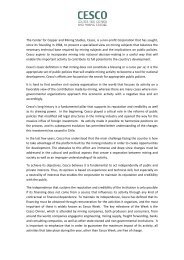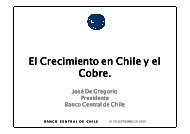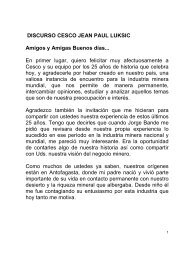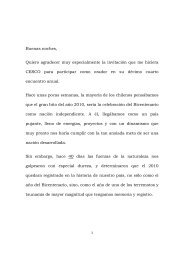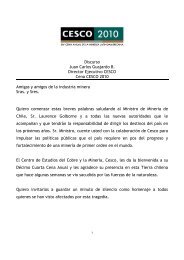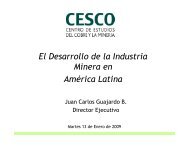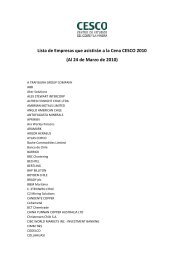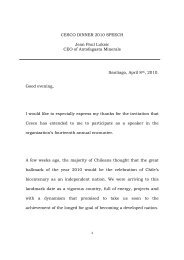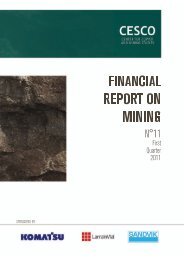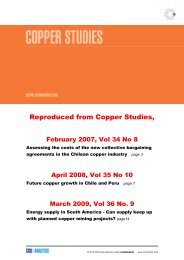A Special Report from Metals Economics Group for the ... - Cesco
A Special Report from Metals Economics Group for the ... - Cesco
A Special Report from Metals Economics Group for the ... - Cesco
- No tags were found...
You also want an ePaper? Increase the reach of your titles
YUMPU automatically turns print PDFs into web optimized ePapers that Google loves.
A <strong>Special</strong> <strong>Report</strong> <strong>from</strong> <strong>Metals</strong> <strong>Economics</strong> <strong>Group</strong><strong>for</strong> <strong>the</strong> PDAC International Convention
WorldwideExplorationTrendsNonferrous exploration rebounds 45% to second-highest total on recordResponding to rising metals prices and more stable markets, most miningcompanies increased <strong>the</strong>ir exploration budgets in 2010. The result was a 45%increase in estimated worldwide nonferrous metals exploration spending 1compared with 2009.<strong>Metals</strong> <strong>Economics</strong> <strong>Group</strong>’s (MEG) 21st edition of Corporate Exploration Strategies (CES)reports a 2010 exploration budget total of $11.2 billion. The industry restored almost twothirdsof <strong>the</strong> $5.5 billion that was cut <strong>from</strong> exploration in 2009 in response to <strong>the</strong> globalfinancial crisis. The speed and <strong>the</strong> strength of <strong>the</strong> 2010 rebound were a welcome surpriseto many, given <strong>the</strong> severity of <strong>the</strong> downturn and widespread <strong>for</strong>ecasts of a deep andprotracted recession.Regionally, Latin America (led by Mexico, Peru, Chile, Brazil, and Argentina) was <strong>the</strong> topexploration destination in 2010—a position it has held <strong>for</strong> <strong>the</strong> better part of two decades—while Canada was <strong>the</strong> top country overall. Gold was <strong>the</strong> leading target, attracting morethan half <strong>the</strong> global exploration budget total, with copper a distant second.When uranium allocations are added to <strong>the</strong> $11.2 billion nonferrous total, 2010 plannedexploration spending rises to more than $12.1 billion, a 44% increase <strong>from</strong> <strong>the</strong> 2009 totalincluding uranium.The PDAC is pleased to partner with <strong>Metals</strong><strong>Economics</strong> <strong>Group</strong> in making this special reporton global exploration and industry trendsavailable to our members and Convention 2011delegates. The PDAC continues to utilize <strong>Metals</strong><strong>Economics</strong> <strong>Group</strong>’s services as an essential meansof obtaining in<strong>for</strong>mation on global explorationtrends and strategies. <strong>Metals</strong> <strong>Economics</strong> <strong>Group</strong>is acknowledged as <strong>the</strong> leader in providingcomprehensive in<strong>for</strong>mation, expertise, andanalysis to <strong>the</strong> mining industry, and is <strong>the</strong> premiersource <strong>for</strong> exploration statistics worldwide.— Tony Andrews, Executive Director, PDAC1 MEG’s CES series of studies includes many diversified companies, but specifically excludes explorationbudgets <strong>for</strong> iron ore, coal, aluminum, oil and gas, most industrial minerals, and, until 2007, uranium.Because <strong>the</strong> 2007-10 budget figures including uranium do not allow meaningful year-on-year comparisonswith earlier years’ data that excluded uranium, figures used throughout this <strong>Special</strong> <strong>Report</strong> excludeuranium unless o<strong>the</strong>rwise specified.(All figures are reported in U.S. dollars; all historical exploration figures throughout this reportrepresent dollars of <strong>the</strong> day and have not been inflation adjusted.)
Basis <strong>for</strong> MEG’s estimated nonferrous exploration totalMEG’s 2010 exploration estimate is based on in<strong>for</strong>mation collected <strong>from</strong> more than 3,200mining and exploration companies worldwide, of which almost 2,100 had explorationbudgets reported in <strong>the</strong> Corporate Exploration Strategies (CES) study. These companies(each budgeting at least $100,000) toge<strong>the</strong>r budgeted $10.68 billion <strong>for</strong> nonferrousexploration, which we estimate covers about 95% of worldwide commercially orientednonferrous exploration budgets. Adding our estimates of budgets that we could not obtain,<strong>the</strong> 2010 worldwide exploration budget total reached more than $11.2 billion.Recent editions of <strong>the</strong> CES study also include uranium exploration budgets. The2010 edition covers uranium budgets totaling almost $830 million. Including uranium,<strong>the</strong> number of companies covered by <strong>the</strong> study increased to more than 2,200, and <strong>the</strong>aggregate exploration budget (including <strong>the</strong> $10.68 billion nonferrous total above)increased to $11.5 billion. Including estimates <strong>for</strong> budgets MEG could not obtain,worldwide nonferrous planned exploration expenditures, including uranium allocations,totaled more than $12.1 billion in 2010.The granular uranium budget data required to make meaningful year-on-yearcomparisons in all figures throughout this report is not available. As a result, mostof <strong>the</strong> analysis throughout <strong>the</strong> remainder of this report discusses comparable figuresexcluding uranium.Summary of overall trendsRiding <strong>the</strong> wave of rising metals prices, worldwide nonferrous exploration allocationsincreased <strong>for</strong> six consecutive years to an all-time high of $13.2 billion in 2008 (excludinguranium). The mining industry’s boom years came to an abrupt halt in September 2008,however, as <strong>the</strong> world fell into <strong>the</strong> worst economic and financial downturn in decades.Widespread <strong>for</strong>ecasts of a deep and protracted global recession painted a grim outlook<strong>for</strong> near-term global commodities demand, pushing most metals prices into steep declineand <strong>for</strong>cing companies to slash <strong>the</strong>ir 2009 exploration plans—some by choice and o<strong>the</strong>rsto survive. The resulting 42% drop (about $5.5 billion) in worldwide nonferrous explorationbudgets <strong>from</strong> <strong>the</strong> 2008 high was <strong>the</strong> largest year-on-year decline (in both dollar andpercentage terms) since MEG began <strong>the</strong> CES series in 1989.After bottoming in early 2009, <strong>the</strong> industry recovered much more quickly than mostwould have dared predict. Although <strong>the</strong> recovery remained fragile, <strong>the</strong> global economyimproved markedly over <strong>the</strong> course of 2009 and into 2010. <strong>Metals</strong> prices improved steadilysince bottoming in early 2009, and were again well above <strong>the</strong>ir long-term trends throughmost of 2010. Responding to rising prices and more stable market conditions, mostcompanies increased <strong>the</strong>ir exploration budgets in 2010, resulting in a 45% increase ($3.5billion) in our estimated exploration budget total <strong>for</strong> 2010, restoring almost two-thirds of2009’s estimated $5.5 billion cut.O<strong>the</strong>r exploration metrics: trends are mixedIn cutting <strong>the</strong>ir 2009 exploration budgets, many companies also reduced both <strong>the</strong> numberof projects <strong>the</strong>y were actively exploring 2 and <strong>the</strong>ir drilling plans in order to cut costs andconserve cash <strong>for</strong> high-priority assets. Unsurprisingly, given <strong>the</strong> sharp rebound in 2010,Worldwide Exploration Budget Totals, 2010(US$ billion)Excluding UraniumWorldwide Nonferrous ExplorationTotal* (2,089 companies)Estimated Worldwide NonferrousExploration Total**Including UraniumWorldwide Nonferrous ExplorationTotal* (2,213 companies)Estimated Worldwide NonferrousExploration Total**Figure 1: Estimated Worldwide Exploration Budget Totals,1993–2010Fig w indxd price (Au+Base)Nonferrous Exploration (US$ bil)$14$12$10$8$6$4$2Nonferrous Exploration Total Uranium Exploration Total*Annual Indexed <strong>Metals</strong> Price$093 94 95 96 97 98 99 00 01 02 03 04 05 06 07 08 09 10* 1993-2006 uranium totals are MEG estimates based on totals reportedin <strong>the</strong> OECD 2007 Red Book; 2007-2010 uranium totals are basedon figures compiled as part of <strong>the</strong> CES studies.© <strong>Metals</strong> <strong>Economics</strong> <strong>Group</strong>, 2011$10.68$11.2$11.51$12.1* MEG estimates that <strong>the</strong> companies covered by <strong>the</strong> CES account<strong>for</strong> about 95% of nonferrous exploration budgets.**Includes <strong>the</strong> additional 5% of planned expenditures MEG couldnot obtain.3.53.02.52.01.51.00.50.0Annual Indexed <strong>Metals</strong> Price (1993=1)2 As part of its annual exploration survey, MEG asks companies to quantify a number of explorationmetrics, including: <strong>the</strong> number of geoscientists/geologists employed by <strong>the</strong>ir exploration department; <strong>the</strong>number of projects being explored, <strong>the</strong> approximate area held <strong>for</strong> exploration; and <strong>the</strong> amount of drillingplanned <strong>for</strong> <strong>the</strong> year. While <strong>the</strong> response rate to this part of our survey is relatively low and <strong>for</strong> certaingroups may be skewed towards companies focusing on a particular commodity (i.e., most comparablemajors are focused on base metals; most comparable intermediates are gold-focused), <strong>the</strong> results do allowus to make year-on-year generalizations among <strong>the</strong> different company classifications.© Copyright <strong>Metals</strong> <strong>Economics</strong> <strong>Group</strong>, 2011. All rights reserved.Reproduction in whole or in part without prior written permissionis prohibited. <strong>Metals</strong> <strong>Economics</strong> <strong>Group</strong> represents that <strong>the</strong> in<strong>for</strong>mationcontained in this report has been collected and compiled in good faith<strong>from</strong> a variety of sources but makes no warranty as to <strong>the</strong> accuracyof <strong>the</strong> in<strong>for</strong>mation <strong>from</strong> those sources.3
most companies with comparable figures planned significantly more drilling—a 48%increase in <strong>the</strong> aggregate planned drilling by a group of juniors with comparable data, a20% aggregate increase among majors, and a 14% increase by intermediate companies.However, despite <strong>the</strong> strong recovery in exploration budgets and planned drill programs,<strong>the</strong> aggregate number of projects being explored by <strong>the</strong> group of junior companiesdropped 10% in 2010 after falling 20% in 2009, while majors and intermediates reporteddeclines of 6% and 16% respectively. In step with <strong>the</strong>se trends, <strong>the</strong> total amount of groundheld <strong>for</strong> exploration by comparable juniors declined 6% in 2010 (on top of a 45% cut in2009), compared with a one-third increase in <strong>the</strong> area held <strong>for</strong> exploration by <strong>the</strong> group ofmajors (following <strong>the</strong>ir own 45% drop in 2009). Intermediate companies maintained <strong>the</strong>irlandholdings at about <strong>the</strong> same level year on year. While <strong>the</strong>se trends are generalized,<strong>the</strong> data suggests that a number of juniors are focusing substantially more drilling onrelatively few high-priority projects, while <strong>the</strong> one-third increase in area held <strong>for</strong> explorationby <strong>the</strong> majors suggests that at least some may have taken advantage of <strong>the</strong> 2009 dip inexploration activity to expand <strong>the</strong>ir exploration footprint, ei<strong>the</strong>r through stakingor acquisitions.Companies with comparable figures also reduced <strong>the</strong>ir exploration departments in2009, reporting an aggregate decrease of 16% in exploration geoscientists. As budgetsrebounded in 2010, <strong>the</strong>se companies made no net staffing change year on year. Juniorand intermediate companies with comparable figures increased <strong>the</strong>ir exploration staffsby 10% and 8% respectively, but <strong>the</strong> majors continued to retrench, reporting 12% fewergeoscientists in 2010 on top of a 5% drop in 2009. Despite <strong>the</strong> apparent decrease over <strong>the</strong>past two years, concerns over a looming skills shortage <strong>the</strong> industry faced prior to mid-2008 are re-emerging as industry growth recovers; as a result, we expect to see an increasein <strong>the</strong> number of geoscientists employed by all industry groups in 2011.Exploration spending increased in all regions,reversing <strong>the</strong> 2009 declinePlanned exploration spending increased in all regions 3 of <strong>the</strong> world in 2010, and one—<strong>the</strong>Pacific/Sou<strong>the</strong>ast Asia region—exceeded its previous high, set in 2008.Latin America drew <strong>the</strong> largest share of allocations, attracting 27% of global spendingin 2010, and has been <strong>the</strong> most popular exploration destination since 1994. Fivecountries—Mexico, Peru, Chile, Brazil, and Argentina—traditionally attract <strong>the</strong> vast majorityof exploration spending in Latin America, and 2010 was no exception. Just 17% of planned2010 exploration in Latin America was targeted outside <strong>the</strong> borders of <strong>the</strong>se five countries.Base metals exploration outpaced gold in Peru, Chile, and Brazil, while gold led <strong>the</strong> way inMexico and Argentina.Canada was also a big draw in 2010, with planned spending rebounding 73%. Thisallowed Canada to regain <strong>the</strong> second spot, which was claimed by MEG’s ‘rest-of-world’region in 2009. The provinces of Ontario, Quebec, Saskatchewan, and British Columbiaattracted about two-thirds of total Canadian allocations. Planned expenditures <strong>for</strong> goldexploration in Canada increased dramatically to capture 54% of total spending.After a year in second position, MEG’s ‘rest of world’ region (covering countries inEurope, mainland Asia, and <strong>the</strong> Middle East) fell back to third. China outpaced Russia<strong>for</strong> <strong>the</strong> first time as <strong>the</strong> top exploration destination in this region, and toge<strong>the</strong>r <strong>the</strong> twocountries accounted <strong>for</strong> half <strong>the</strong> region’s 2010 total. Gold was <strong>the</strong> leading target in <strong>the</strong>region, attracting 49% of recorded budgets.Africa continued to attract more exploration spending than Australia, accounting <strong>for</strong>13% of 2010’s global budgets compared with Australia’s 12%. Planned spending in Africa3 The annual budget totals <strong>for</strong> Canada, Australia, and <strong>the</strong> United States are typically much larger than<strong>for</strong> most o<strong>the</strong>r countries; as a result, MEG also treats <strong>the</strong>se countries as regions in its CES studies.Figure 2: Worldwide Nonferrous Exploration Budgets by RegionExploration Budgets by Region, 2010(2,089 companies‘ budgets totaling $10.68 billion)Australia12%United States8%Africa13%Pacific/Sou<strong>the</strong>astAsia7%Rest of World14%Exploration Budgets by Region, 2006-10(as a percentage of annual exploration totals)30%25%20%15%10%5%0%LatinAmericaCanada© <strong>Metals</strong> <strong>Economics</strong> <strong>Group</strong>, 20112006 2007 2008 2009 2010Rest ofWorldLatin America27%Canada19%Africa Australia UnitedStatesPacific/SE Asia4
was heavily weighted towards five countries: Democratic Republic of Congo, South Africa,Zambia, and Burkina Faso, which toge<strong>the</strong>r accounted <strong>for</strong> almost half <strong>the</strong> region’s total. InAustralia, three states—Western Australia, Queensland, and New South Wales—toge<strong>the</strong>raccounted <strong>for</strong> three-quarters of <strong>the</strong> region’s total allocations. Gold was <strong>the</strong> top explorationtarget in both Africa and Australia.The United States region remains firmly entrenched in sixth place. Never<strong>the</strong>less, itboasts <strong>the</strong> largest year-on-year increase in planned exploration spending in 2010, rising75% <strong>from</strong> 2009 and increasing its share of worldwide spending to 8% <strong>from</strong> 6.5%. Goldallocations in Nevada and Alaska account <strong>for</strong> a large portion of <strong>the</strong> total; however, basemetals exploration in Arizona and Minnesota also contributed to <strong>the</strong> increased activity.Planned exploration in <strong>the</strong> Pacific/Sou<strong>the</strong>ast Asia region also increased substantiallyin 2010. While its share of worldwide exploration increased in recent years to almost 7%in 2010, it remains well below <strong>the</strong> 10%-12% range reached in <strong>the</strong> mid-to-late-1990s. Thetraditional big three destinations—Indonesia, Papua New Guinea, and <strong>the</strong> Philippines—attracted 75% of <strong>the</strong> region’s total allocations in 2010.In most years, <strong>the</strong> bulk of global exploration spending is carried out by Canada- andAustralia-based companies; however, resource-hungry China is also becoming anincreasingly important investor in mineral exploration worldwide. In 2010, Chinesecompanies accounted <strong>for</strong> about 11% of <strong>the</strong> global exploration total, with about 31% of<strong>the</strong>ir budgets allocated outside China’s borders—primarily targeting Canada, Africa, andPacific/Sou<strong>the</strong>ast Asia regions.Top ten countries show increased emphasison United States and MexicoAs one would expect in a year in which exploration spending jumped 45%, most countriessaw year-on-year increases in allocations (<strong>the</strong> 2010 CES study documents explorationallocations in 123 individual countries; 125 when uranium is included). The top tenindividual countries in 2010 accounted <strong>for</strong> 69% of <strong>the</strong> overall budget. Although <strong>the</strong>irrelative positions shifted, <strong>the</strong> top nine countries were <strong>the</strong> same as in 2009. Canada andAustralia continued to head <strong>the</strong> list in 2010, with Canada’s lead over Australia increasing<strong>from</strong> about $260 million in 2009 to $755 million. The United States and Mexico movedFigure 3: Exploration Budgets <strong>for</strong> <strong>the</strong> Top Ten Countries, 2010(top ten countries account <strong>for</strong> 69% of total budgets)O<strong>the</strong>r Countries31%Argentina3%Brazil3%Russia4%China4%© <strong>Metals</strong> <strong>Economics</strong> <strong>Group</strong>, 2011Chile5%Peru5%Canada19%Australia12%United States8%Mexico6%Figure 4: Exploration Budgets <strong>for</strong> <strong>the</strong> Top Ten Countries, 2010Canada19%4%RussiaUnited States8%Mexico6%4%ChinaPeruChile5%5%3%3%ArgentinaBrazil12%Australia113 o<strong>the</strong>r countries 31%© <strong>Metals</strong> <strong>Economics</strong> <strong>Group</strong>, 20115
ahead of Peru to take third and fourth spots, putting <strong>the</strong> U.S. back among <strong>the</strong> traditional bigthree. Peru dropped <strong>from</strong> third to fifth place, while Chile rose <strong>from</strong> seventh to sixth. Chinarose <strong>from</strong> eighth to seventh place, Russia dropped <strong>from</strong> fifth to eighth, Brazil remained inninth place, and Argentina replaced South Africa in tenth place.Despite increases in most countries, <strong>the</strong> industry’s overall appetite <strong>for</strong> risk did notreturn to levels seen prior to <strong>the</strong> economic downturn. Companies continue to face <strong>the</strong>threat of resource nationalism, as more countries openly consider or enact windfall andresource rent taxes, increase royalties, or impose o<strong>the</strong>r controls on <strong>for</strong>eign companiessuch as revoking or freezing licenses <strong>for</strong> review. As a result, exploration in a number ofcountries considered to be high risk continued to fall in 2010, while o<strong>the</strong>r countries wi<strong>the</strong>levated risk profiles showed only modest increases far below <strong>the</strong> global average. Earlystageexploration, which is <strong>the</strong> most mobile and tends to be cut first when risk levels rise (ortolerance <strong>for</strong> risk declines), has all but dried up in many high-risk countries; <strong>the</strong> explorersthat remain are focused on advanced projects and mines that are difficult to abandon.Gold attracts record explorationFollowing steep declines in exploration allocations in 2009, budgets <strong>for</strong> all targets coveredby <strong>the</strong> CES study resumed <strong>the</strong>ir upward trend in 2010, with <strong>the</strong> exception of diamonds,which dropped 9% year on year.In 2010, global economic fundamentals kept <strong>the</strong> spotlight on gold, and historically highprices prompted gold explorers to increase <strong>the</strong>ir aggregate budget by $1.9 billion. Thisincrease lifted planned spending on <strong>the</strong> yellow metal to $5.4 billion and its share of totalbudgets to 51%—<strong>the</strong> first time since 1999 that gold accounted <strong>for</strong> more than half of totalplanned spending and <strong>the</strong> highest dollar total in <strong>the</strong> history of <strong>the</strong> CES. Ten countries—Canada, Australia, United States, Mexico, Russia, China, Peru, Colombia, Brazil, and Chile—accounted <strong>for</strong> two-thirds of <strong>the</strong> 2010 gold exploration budget total.Overall, base metals exploration budgets (aggregating copper, nickel, and zinc) alsobounced back in 2010, but did not exceed <strong>the</strong>ir 2008 peak of more than $5 billion. As apercentage of global exploration activity, base metals accounted <strong>for</strong> 33%—<strong>the</strong> secondconsecutive decline since a high of almost 41% of global exploration in 2008. Latin Americaconsistently accounts <strong>for</strong> <strong>the</strong> largest share of worldwide base metals budgets, topping 33%in 2010—<strong>the</strong> region’s largest share since 2003.The 9% decline in diamond allocations in 2010 represented just 3% of worldwideexploration—a far cry <strong>from</strong> almost 15% in 2003 and <strong>the</strong> lowest share recorded in <strong>the</strong> 21-year history of <strong>the</strong> CES. Canada, Russia, and sou<strong>the</strong>rn African countries continued to be <strong>the</strong>primary destinations <strong>for</strong> diamond exploration.Compared with 2009, PGM exploration increased a relatively minor 13% in 2010. Asa result, PGM’s share of worldwide spending slipped below 2%, continuing <strong>the</strong> steadyerosion of its share of global spending since reaching 6% in 2002 and 2003. Almost half ofPGM allocations were destined <strong>for</strong> Africa, with Canada receiving about a third.Budgets <strong>for</strong> <strong>the</strong> ‘o<strong>the</strong>r targets’ group of commodities almost doubled <strong>from</strong> 2009, butfell just shy of <strong>the</strong>ir 2008 peak of $1.3 billion. Silver accounted <strong>for</strong> more than a third of <strong>the</strong>‘o<strong>the</strong>r targets’ total; however, most silver exploration occurs in conjunction with <strong>the</strong> search<strong>for</strong> gold or base metals polymetallic deposits. Potash and phosphates—by far <strong>the</strong> mostpopular targets among <strong>the</strong> remaining ‘o<strong>the</strong>r targets’—attracted more than 20% of <strong>the</strong>group’s total. As market interest in lithium and rare earth elements continued to increase in2010, exploration budgets <strong>for</strong> <strong>the</strong>se commodities jumped to almost four times <strong>the</strong> amountspent in 2009. Never<strong>the</strong>less, <strong>the</strong>y remain a relatively small part of <strong>the</strong> industry’s overallexploration ef<strong>for</strong>t, accounting <strong>for</strong> about 13% of <strong>the</strong> 2010 ‘o<strong>the</strong>r targets’ total.Figure 5: Worldwide Exploration Budgets by TargetExploration Budgets by Target, 2010(2,089 companies‘ budgets totaling $10.68 billion)PGM2%Diamonds3%Base <strong>Metals</strong>33%O<strong>the</strong>r11%Exploration Budgets by Target, 2006–10(as a percentage of annual exploration totals)60%50%40%30%20%10%0%Gold51%Gold Base <strong>Metals</strong> Diamonds PGM O<strong>the</strong>r© <strong>Metals</strong> <strong>Economics</strong> <strong>Group</strong>, 20112006 2007 2008 2009 20106
Uranium exploration rebound was mutedThe CES study began covering uranium budgets in 2007. Although specifically excluded<strong>from</strong> <strong>the</strong> figures used in this report 4 , <strong>the</strong> 2010 CES includes 272 companies reportinguranium allocations, with aggregate uranium budgets up 24% <strong>from</strong> 2009—well below<strong>the</strong> worldwide average increase <strong>for</strong> all commodities. Uranium spending represents morethan 7% of <strong>the</strong> $11.5 billion in worldwide exploration budgets covered when includinguranium—a higher percentage than <strong>the</strong> allocation <strong>for</strong> diamonds <strong>for</strong> <strong>the</strong> third consecutiveyear.Emphasis continues to be on late-stage explorationPlanned spending <strong>for</strong> all stages of exploration increased in 2010, and <strong>the</strong> recent trend ofincreased emphasis on late-stage exploration continued. Late-stage budgets increased <strong>the</strong>most year on year (up 52% <strong>from</strong> 2009) to account <strong>for</strong> about 42% of <strong>the</strong> worldwide total,while <strong>the</strong> rise in grassroots budgets was on par with <strong>the</strong> worldwide increase, keeping itsshare of <strong>the</strong> overall total flat at just under 33%. Minesite budgets increased more modestlyat 35% year on year, dropping its share of <strong>the</strong> global total to 25%.Late-stage spending outweighed grassroots spending <strong>for</strong> <strong>the</strong> past six years. Grassroots’percentage of budgets has generally declined since <strong>the</strong> mid-1990s, and dropped anaverage of 2.5% annually <strong>from</strong> a recent high of 52% in 2001 to a record low of about 33%in 2009 and 2010. This decline correlates with <strong>the</strong> upward trend in late-stage budgets,as companies spend more on late-stage projects to move <strong>the</strong>m towards production ormake <strong>the</strong>m attractive <strong>for</strong> acquisition in <strong>the</strong> metals price environment of <strong>the</strong> past six years.Similarly, minesite’s share of overall spending increased in recent years as producers view itas a more economical and less risky means of replacing and adding to reserves.The stabilization in grassroots’ overall percentage in 2010 at least temporarily halted<strong>the</strong> erosion of its share of <strong>the</strong> worldwide total; however, <strong>the</strong> proportional shift away <strong>from</strong>grassroots spending over <strong>the</strong> past cycle could put pressure on future production. Withcompanies of all types focusing less on grassroots work, <strong>the</strong>re is some concern that manycompanies, and perhaps <strong>the</strong> industry in general, may be sacrificing long-term projectpipelines in favor of short-term growth.4 Since <strong>the</strong> granular uranium budget data required to make meaningful year-on-year comparison wi<strong>the</strong>arlier years’ data is unavailable, uranium allocations are excluded <strong>from</strong> most figures used in this report.Figure 6: Worldwide Exploration Budgets by Stageof DevelopmentExploration Budgets by Stage of Development, 2010(2,089 companies‘ budgets totaling $10.68 billion)Minesite25%Late Stage42%Grassroots33%Exploration Budgets by Stage of Development, 2006-10(as a percentage of annual exploration totals)45%40%35%30%25%20%15%10%5%0%2006 2007 2008 2009 2010Grassroots Late Stage Minesite© <strong>Metals</strong> <strong>Economics</strong> <strong>Group</strong>, 2011Looking <strong>for</strong>wardSince bottoming in early 2009, metals prices,and <strong>the</strong> mining and exploration industry asa whole, have recovered much more quicklythan most had predicted. Many mines andprojects that were stalled in 2008-09 areback on track, and exploration spendingrebounded strongly in 2010.Looking ahead, resource-hungryemerging and developing economies areprojected to continue to lead global GDPgrowth and demand <strong>for</strong> metals over <strong>the</strong> nextfew years. On <strong>the</strong> supply side, many of <strong>the</strong>limitations <strong>the</strong> industry faced prior to <strong>the</strong>2008 decline remain in effect. The lack ofexploration and mine development in <strong>the</strong> late1990s and early 2000s, as well as declininghead grades, power shortages, industrialactions, government and NGO interruptions,and operational failures at existing mines,constrained meaningful increases in <strong>the</strong>production of most metals, and many of <strong>the</strong>sefactors will continue to do so in <strong>the</strong> near term.Based on <strong>the</strong> above, most analysts agreethat metals prices—<strong>the</strong> primary driver ofexploration spending—will remain strongor continue to rise in 2011, at least in U.S.dollar terms. In addition, we expect <strong>the</strong>cost of exploration to continue rising in2011, as increased activity leads to greatercompetition <strong>for</strong> services, and o<strong>the</strong>r inputcosts grow. As a result, we expect ano<strong>the</strong>rhealthy increase in <strong>the</strong> 2011 explorationbudget total relative to 2010, rising toset a new high-water mark <strong>for</strong> worldwidenonferrous exploration spending.7
For three decades, <strong>Metals</strong> <strong>Economics</strong> <strong>Group</strong> (MEG) has been <strong>the</strong> most trusted source of global miningin<strong>for</strong>mation and analysis. From worldwide exploration, development, and production to strategic planningand acquisitions—our experienced and knowledgeable researchers and analysts provide <strong>the</strong> highest-qualityservices to all facets of <strong>the</strong> industry. MEG services are <strong>the</strong> foundation <strong>for</strong> confident growth decisions—allowing users to quickly gain efficiencies through easy-to-use online databases, and by accessingcredible, reliable research <strong>for</strong> clearer insights and better decisions.MEG maintains a global presence with client representation across a broad range of sectors including• Major international mining companies• Banks• Investment and fund managers• Service and equipment providers• Intermediate and junior mining companiesfocused on growth• Governments• Consulting firmsWe offer our clients <strong>the</strong> ability to identify new business opportunities; analyze details to benchmark,compare, and value; monitor competitors and market trends; and act more efficiently and with moreconfidence, using a recognized, unbiased source to back decisions and actions.For more in<strong>for</strong>mation on howwe can be of service to you,please visit our web site atwww.metalseconomics.comor call 902-429-2880.<strong>Metals</strong> <strong>Economics</strong> <strong>Group</strong>Suite 300, 1718 Argyle StreetHalifax, Nova ScotiaB3J 3N6, CanadaPhone +1 902-429-2880Fax +1 902-429-6593© <strong>Metals</strong> <strong>Economics</strong> <strong>Group</strong>, 2011. All rights reserved.<strong>Metals</strong> <strong>Economics</strong> <strong>Group</strong> ServicesFor professionals around <strong>the</strong> world working with mining-related in<strong>for</strong>mation, MEG’s services are indispensible—independent, insightful,and instantly applicable to your business needs.MineSearchSearch continuously updated profiles onthousands of global mining projects andcompanies—using <strong>the</strong> highest quality andhistorically rich source of worldwide project andcompany in<strong>for</strong>mation in <strong>the</strong> mining industry.View in<strong>for</strong>mation <strong>the</strong> way you want—in textor with flexible maps including proximitysearches, multiple map layers, and new thisyear, high-quality satellite and relief maps, witha biodiversity data layer.Acquisitions ServiceEvaluate and compare—<strong>the</strong> competitive edgein project and company valuation. Supportyour deal-making discussions and decisionswith complete, authoritative, and relevanttransaction in<strong>for</strong>mation collected <strong>for</strong> twodecades. Per<strong>for</strong>m quick comparisons andevaluations of transactions on a cost per poundor ounce basis.Watch <strong>for</strong> a new interface and new featuresin early 2012.Exploration Activity ServiceA comprehensive view of junior andintermediate company growth and financingactivities—<strong>the</strong> critical in<strong>for</strong>mation and analysisyou need to support and justify exploration,financing, and deal-making activities, as well asto monitor <strong>the</strong> environment <strong>for</strong> marketing andsales opportunities.A fresh design and enhanced features areplanned <strong>for</strong> 2012.Corporate Exploration StrategiesThe industry’s only source of global miningexploration spending and strategies. CorporateExploration Strategies is <strong>the</strong> industry’sbenchmark <strong>for</strong> exploration trends and strategicanalysis. Benefit <strong>from</strong> both a global and agranular view—backed by in<strong>for</strong>mation youcan trust.October 2011 will mark <strong>the</strong> 22nd edition of<strong>the</strong> study.Reserves Replacement StrategiesDetailed examinations of how—and at whatcost—<strong>the</strong> majors are replacing reserves <strong>for</strong>copper, gold, and nickel. A thorough analysisof reserves and production profiles <strong>for</strong> majorproducers, discoveries of large deposits,exploration budgets, acquisitions anddivestitures, and project pipelines.The 2011 edition of Copper ReservesReplacement Strategies will be publishedin June 2011.Strategic Advisory ServicesIndustry MonitorA series of graphs with commentary trackdevelopments and analyze data and in<strong>for</strong>mationonly available <strong>from</strong> MEG—an up-to-dateoverview of emerging trends in exploration,project development, financings, andacquisitions in <strong>the</strong> precious and base metalspipeline.Strategic <strong>Report</strong>Insight and deep analysis on critical supply-sideissues facing <strong>the</strong> global mining industry—<strong>the</strong>MEG Strategic <strong>Report</strong> includes in<strong>for</strong>mation andanalysis on acquisitions, capital and productioncosts, exploration, company activity, metalsoutlooks, supply pipelines, project statuschanges, and smelting and refining charges.MEG WebsiteSpring 2011, MEG will launch a new publicwebsite with a web-based store, offering <strong>the</strong>convenience of purchasing reports online.




